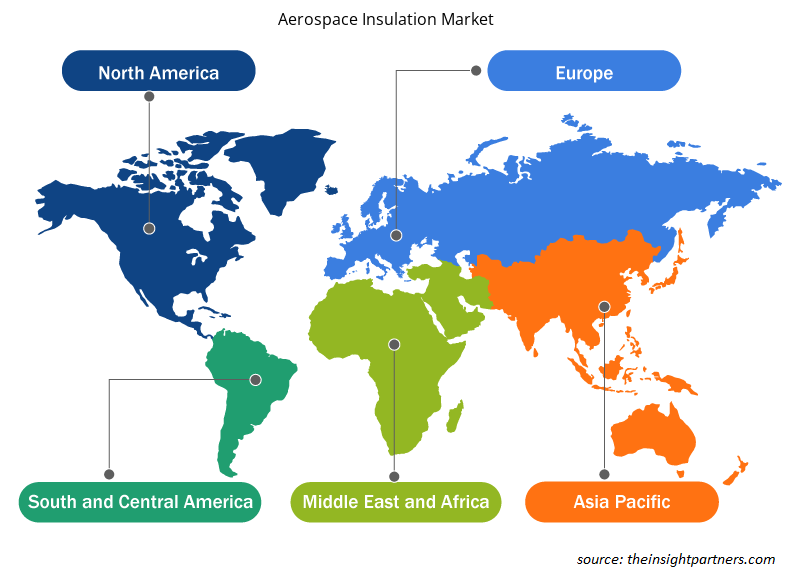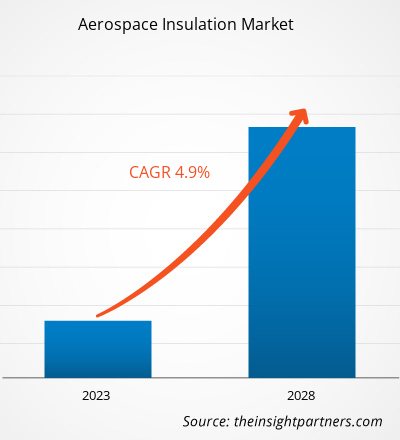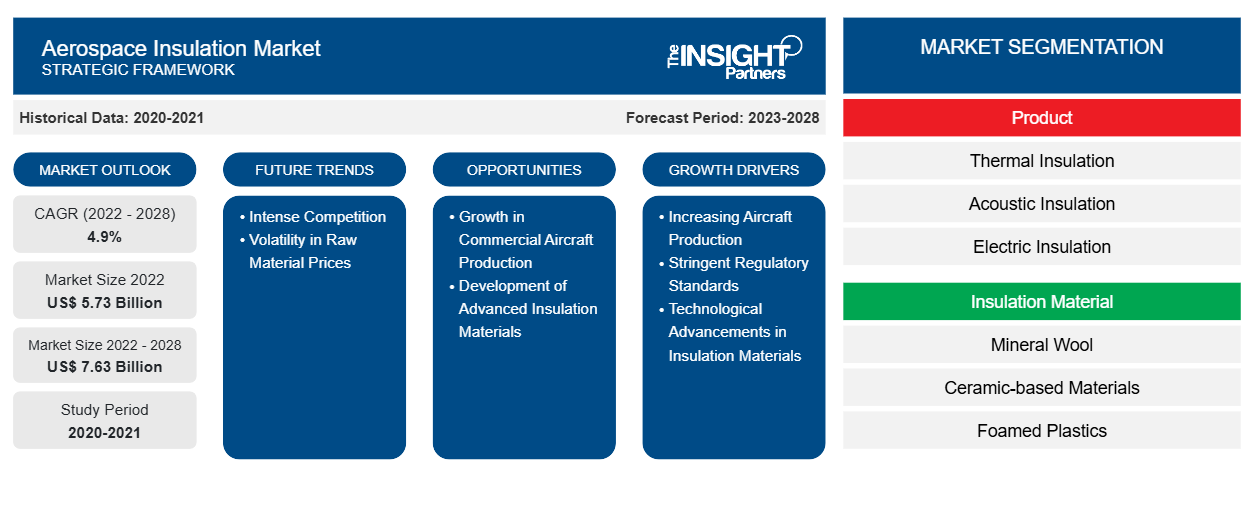Si prevede che il mercato dell'isolamento aerospaziale crescerà da 5.731,28 milioni di dollari nel 2022 a 7.633,23 milioni di dollari entro il 2028; si stima che crescerà a un CAGR del 4,9% dal 2022 al 2028.
L'isolamento aerospaziale si riferisce al materiale installato nell'aeromobile per migliorare i livelli di sicurezza e comfort. Le funzioni dell'aeromobile in condizioni climatiche severe devono rispettare determinate operazioni fondamentali e misure di sicurezza riguardanti sia i termini di peso e temperatura che le prestazioni complessive. Grazie ai vantaggi, come i minori livelli di vibrazione e rumore durante le ore di volo, la domanda di materiali isolanti sta crescendo a un ritmo rapido. Si prevede che il crescente utilizzo di materiali compositi negli aerei commerciali spingerà lo sviluppo di diverse aerostrutture, con conseguente potenziale industriale sostanziale. La crescente domanda di materiali isolanti leggeri e materiali compositi nei settori degli aerei commerciali e dei jet privati per ridurre il rumore in cabina guiderà probabilmente il mercato nei prossimi anni.
L'isolamento aerospaziale svolge un ruolo cruciale nella protezione dell'equipaggio e dei passeggeri dal rumore del generatore e dalle temperature gelide alle altitudini più elevate. La crescente domanda di aeromobili leggeri, di nuova generazione e a basso consumo di carburante, con la crescente importanza della riduzione delle emissioni, dovrebbe aumentare la produzione di aeromobili. Il significativo sviluppo del settore dei viaggi nei mercati emergenti e il crescente numero di passeggeri per viaggi internazionali e nazionali sono i principali fattori che guidano il mercato globale dell'isolamento aerospaziale . Ad esempio, secondo l'International Air Transport Association (IATA), la domanda totale di viaggi aerei ad aprile 2022 è aumentata del 78,7% rispetto ad aprile 2021.
Personalizza questo report in base alle tue esigenze
Riceverai la personalizzazione gratuita di qualsiasi report, comprese parti di questo report, o analisi a livello nazionale, pacchetto dati Excel, oltre a usufruire di grandi offerte e sconti per start-up e università
- Scopri le principali tendenze di mercato in questo rapporto.Questo campione GRATUITO includerà analisi di dati che spaziano dalle tendenze di mercato alle stime e alle previsioni.
Secondo la Federal Aviation Administration (FAA), tutti gli aerei commerciali devono avere un isolamento termico e acustico. Questi isolanti assicurano che il comfort dei passeggeri non sia influenzato dalle variazioni della temperatura esterna e che il rumore eccessivo creato dall'aereo non interferisca con la comunicazione. Tali severe normative incoraggiano i produttori di aeromobili a utilizzare materiale isolante negli aeromobili, dando impulso al mercato dell'isolamento aerospaziale.
Molti produttori di isolamento aerospaziale come Zotefoams stanno sviluppando materiali da costruzione aerospaziali leggeri per aumentare l'efficienza del carburante e la sostenibilità. L'isolamento termico e acustico protegge da rumore e temperatura eccessivi nella maggior parte degli aeromobili. L'isolamento termico e acustico è una fibra unica ad alte prestazioni racchiusa in una copertura in plastica classificata per aeromobili che tiene insieme i materiali isolanti e funge anche da barriera contro l'umidità.
Approfondimenti di mercato
La crescita nel settore del trasporto aereo stimola il mercato dell'isolamento aerospaziale
Il settore del trasporto aereo si sta espandendo rapidamente e si prevede che continuerà così nei prossimi anni. Secondo la stima dell'International Air Transport Association (IATA), si prevede che la domanda di trasporto aereo aumenterà in media del 4,3% all'anno fino al 2036. Se questa crescita verrà raggiunta entro il 2036, si prevede che il settore del trasporto aereo contribuirà a 15,5 milioni di posti di lavoro diretti e 1,5 trilioni di dollari di PIL all'economia mondiale durante il periodo di previsione. Una crescita così significativa della domanda di trasporto aereo porterà a una maggiore domanda di aeromobili. L'isolamento aerospaziale viene utilizzato negli aeromobili per aumentare il comfort e la sicurezza degli aeromobili e dei viaggiatori, il che dovrebbe far progredire il mercato dell'isolamento aerospaziale durante il periodo di previsione. Inoltre, il costo dei materiali compositi è in continuo calo, consentendo ai produttori di aeromobili di utilizzare i compositi per l'isolamento aerospaziale. Pertanto, a causa di tali fattori, il mercato prospererà rapidamente durante il periodo di previsione.
Approfondimenti sui prodotti
In base al prodotto, il mercato dell'isolamento aerospaziale è segmentato in isolamento termico, isolamento acustico, isolamento elettrico e isolamento dalle vibrazioni. Nel 2021, il segmento dell'isolamento termico ha dominato il mercato e si prevede che crescerà a un CAGR più rapido durante il periodo di previsione. Le maggiori attività di ricerca e sviluppo per produrre materiale di isolamento termico avanzato, leggero e sostenibile stanno stimolando la crescita del segmento dell'isolamento termico durante il periodo di previsione.
3M; TransDigm Group Incorporated; Triumph Group, Inc.; Johns Manville; Morgan Advanced Materials Plc; Polymer Technologies Inc.; Duracote Corporation; Rogers Corporation; DuPont; e BASF SE sono i principali attori che operano nel mercato dell'isolamento aerospaziale. I principali attori adottano diverse strategie, come fusioni e acquisizioni e lanci di prodotti, per espandere la loro presenza geografica e la base di consumatori.
Approfondimenti regionali sul mercato dell'isolamento aerospaziale
Le tendenze regionali e i fattori che influenzano il mercato dell'isolamento aerospaziale durante il periodo di previsione sono stati ampiamente spiegati dagli analisti di Insight Partners. Questa sezione discute anche i segmenti e la geografia del mercato dell'isolamento aerospaziale in Nord America, Europa, Asia Pacifico, Medio Oriente e Africa e America meridionale e centrale.

- Ottieni i dati specifici regionali per il mercato dell'isolamento aerospaziale
Ambito del rapporto sul mercato dell'isolamento aerospaziale
| Attributo del report | Dettagli |
|---|---|
| Dimensioni del mercato nel 2022 | 5,73 miliardi di dollari USA |
| Dimensioni del mercato entro il 2028 | 7,63 miliardi di dollari USA |
| CAGR globale (2022 - 2028) | 4,9% |
| Dati storici | 2020-2021 |
| Periodo di previsione | 2023-2028 |
| Segmenti coperti | Per Prodotto
|
| Regioni e Paesi coperti | America del Nord
|
| Leader di mercato e profili aziendali chiave |
|
Densità degli attori del mercato dell'isolamento aerospaziale: comprendere il suo impatto sulle dinamiche aziendali
Il mercato dell'isolamento aerospaziale sta crescendo rapidamente, spinto dalla crescente domanda degli utenti finali dovuta a fattori quali l'evoluzione delle preferenze dei consumatori, i progressi tecnologici e una maggiore consapevolezza dei vantaggi del prodotto. Con l'aumento della domanda, le aziende stanno ampliando le loro offerte, innovando per soddisfare le esigenze dei consumatori e capitalizzando sulle tendenze emergenti, il che alimenta ulteriormente la crescita del mercato.
La densità degli operatori di mercato si riferisce alla distribuzione di aziende o società che operano in un particolare mercato o settore. Indica quanti concorrenti (operatori di mercato) sono presenti in un dato spazio di mercato in relazione alle sue dimensioni o al valore di mercato totale.
Le principali aziende che operano nel mercato dell'isolamento aerospaziale sono:
- Società Duracote
- Società Rogers
- DuPont
- BASF SE
- 3 milioni
Disclaimer : le aziende elencate sopra non sono classificate secondo un ordine particolare.

- Ottieni una panoramica dei principali attori del mercato dell'isolamento aerospaziale
Segnala i riflettori
- Tendenze progressive nel settore dell'isolamento aerospaziale per aiutare gli operatori a sviluppare strategie efficaci a lungo termine
- Strategie di crescita aziendale adottate dalle aziende per garantire la crescita nei mercati sviluppati e in via di sviluppo
- Analisi quantitativa del mercato globale dell'isolamento aerospaziale dal 2021 al 2028
- Stima della domanda di isolamento aerospaziale in vari settori
- Analisi delle cinque forze di Porter per illustrare l'efficacia degli acquirenti e dei fornitori che operano nel settore dell'isolamento aerospaziale
- Sviluppi recenti per comprendere lo scenario competitivo del mercato e la domanda di isolamento aerospaziale
- Tendenze e prospettive di mercato, insieme ai fattori che regolano la crescita del mercato dell'isolamento aerospaziale
- Comprendere le strategie che sostengono l'interesse commerciale in relazione alla crescita del mercato, aiutando nel processo decisionale
- Dimensioni del mercato dell'isolamento aerospaziale in vari nodi di mercato
- Panoramica dettagliata e segmentazione del mercato nonché delle dinamiche del settore
- Dimensioni del mercato dell'isolamento aerospaziale in varie regioni con promettenti opportunità di crescita
"Aerospace Insulation Market Analysis to 2028" è uno studio specializzato e approfondito del settore dei prodotti chimici e dei materiali, incentrato sull'analisi delle tendenze di mercato. Il rapporto mira a fornire una panoramica del mercato con una segmentazione dettagliata. Il mercato dell'isolamento aerospaziale è segmentato in base a prodotto, materiale isolante, aeromobile e geografia. In base al prodotto, il mercato è segmentato in isolamento termico, isolamento acustico, isolamento elettrico e isolamento dalle vibrazioni. In base al materiale isolante, il mercato è segmentato in lana minerale, materiali a base di ceramica, plastica espansa, fibra di vetro e altri. In base agli aeromobili, il mercato è segmentato in motore e cellula. In base alla geografia, il mercato è segmentato in cinque regioni principali: Nord America, Europa, Asia Pacifico, Medio Oriente e Africa e Sud e Centro America. Nel 2021, il Nord America ha dominato il mercato. Tuttavia, si prevede che l'Asia Pacifico registrerà il CAGR più elevato nel mercato durante il periodo di previsione.
- Analisi storica (2 anni), anno base, previsione (7 anni) con CAGR
- Analisi PEST e SWOT
- Valore/volume delle dimensioni del mercato - Globale, Regionale, Nazionale
- Industria e panorama competitivo
- Set di dati Excel
Report recenti
Rapporti correlati
Testimonianze
Motivo dell'acquisto
- Processo decisionale informato
- Comprensione delle dinamiche di mercato
- Analisi competitiva
- Analisi dei clienti
- Previsioni di mercato
- Mitigazione del rischio
- Pianificazione strategica
- Giustificazione degli investimenti
- Identificazione dei mercati emergenti
- Miglioramento delle strategie di marketing
- Aumento dell'efficienza operativa
- Allineamento alle tendenze normative























 Ottieni un campione gratuito per - Mercato dell'isolamento aerospaziale
Ottieni un campione gratuito per - Mercato dell'isolamento aerospaziale